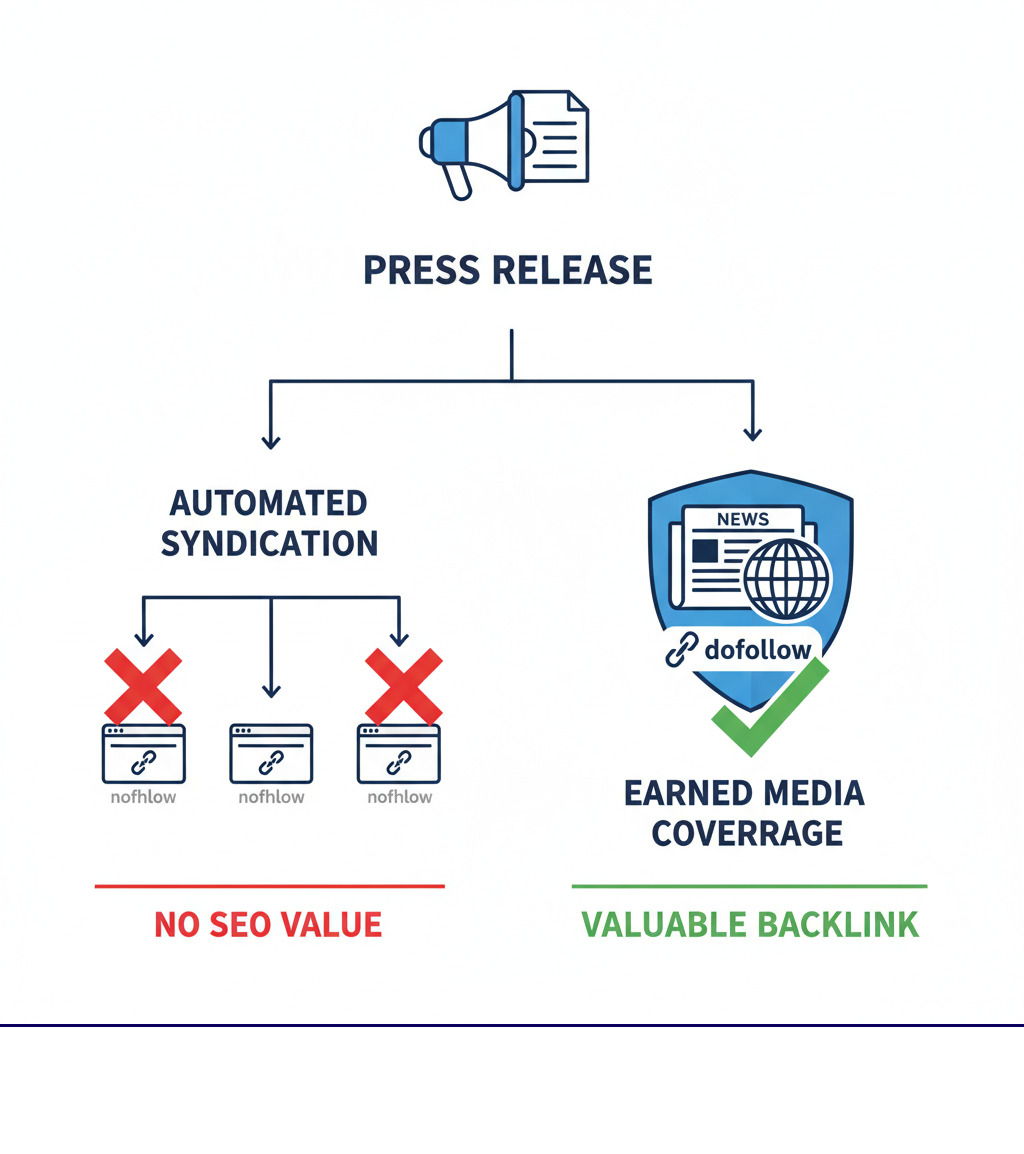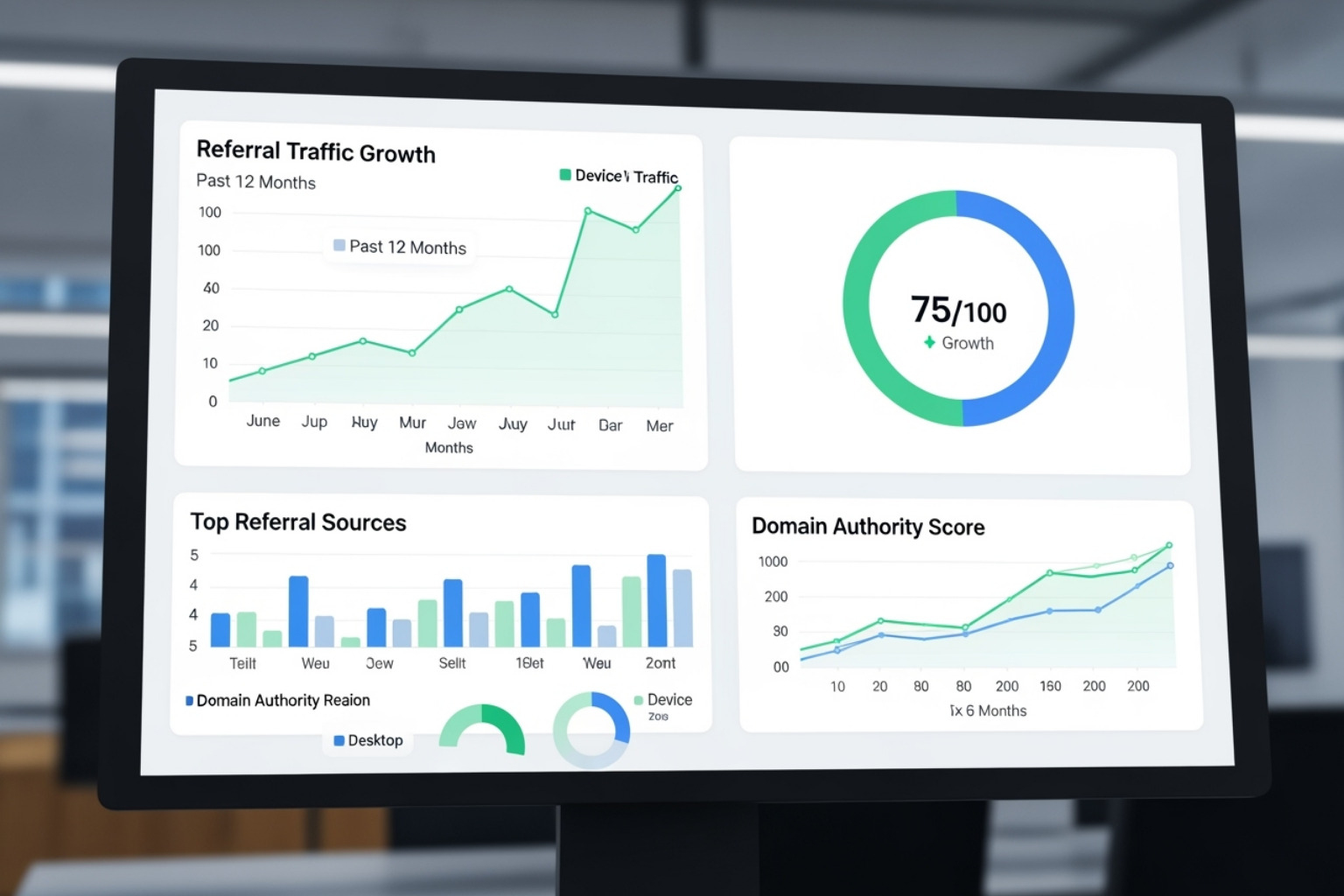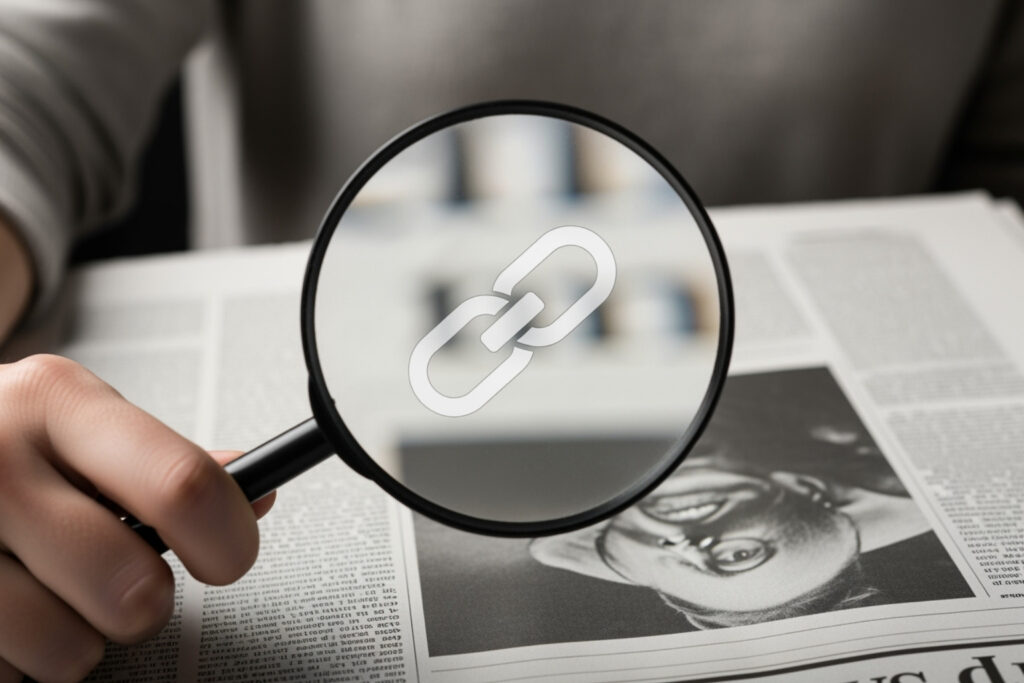Why Press Release Backlinks Matter for Your SEO Strategy
Press Releases for Backlinks: Your Ultimate Guide to Effective Link Building
Press release backlinks are links from news sites pointing to your website, earned through newsworthy announcements. They’re a misunderstood SEO tool: powerful when used correctly, but a waste of resources when not.
Here’s what you need to know:
- Genuine editorial links from reputable news sites are valuable trust signals.
- Syndicated links from automated services offer little to no SEO benefit.
- Quality trumps quantity—one great link is better than hundreds of poor ones.
- Press releases require truly newsworthy content that journalists want to cover.
- The goal is earning media coverage, not just distributing content.
While Google has stated it “ignores” links in press releases, this refers to automated syndication, not genuine media coverage. When a journalist reads your release and writes their own story, the resulting earned media link is a powerful ranking signal that boosts your site’s authority.
Unfortunately, many businesses waste money on automated distribution services that promise hundreds of backlinks but deliver zero SEO value. This guide will teach you how to use press releases strategically to earn high-quality backlinks that actually improve your search rankings.

Relevant articles related to press release backlinks:
The Truth About Press Release Backlinks for SEO
Press release backlinks from high-authority news sources can be gold for your SEO strategy. When a major publication like The New York Times or Forbes links to your website, Google sees it as a powerful trust signal. Your site’s Domain Authority matters; a single link from a reputable outlet can be more impactful than hundreds of low-quality ones because Google’s algorithm rewards trusted editorial links.
The challenge is that most businesses chase quantity over quality, pursuing worthless syndicated links instead of valuable editorial mentions. To learn more about building backlinks that move the needle, see our guide on building quality backlinks for SEO growth.
What Are Press Release Backlinks?
A press release backlink is a link from a media outlet to your website, typically resulting from a newsworthy announcement like a product launch or original research. Beyond link acquisition, this process builds online visibility and brand reputation. However, not all links are equal. While Google has stated they ignore press release links, they are referring to the automated, syndicated kind, not genuine editorial links.
The Critical Difference: Editorial Links vs. Syndicated Links
Understanding this distinction is crucial to avoid wasting your budget.
Syndicated links come from automated services that blast your press release to hundreds of low-quality news aggregators and content farms. These sites republish your content without any editorial review. The links are usually nofollow links or exist on noindexed pages, passing zero SEO value. They are not genuine endorsements.
Editorial links are the goal. They are created when a journalist finds your release newsworthy and writes their own story, including a natural dofollow link to your site. These links come from high-authority sources with real editorial standards, carry significant link equity, and signal to Google that your brand is credible. One editorial link from a major news outlet is worth more than 500 syndicated links.
Why Genuine Press Links Boost Your E-A-T

Google’s E-A-T framework evaluates a site’s Expertise, Authoritativeness, and Trustworthiness, which is critical for search engine rankings. Genuine press release backlinks directly strengthen all three components.
- Expertise: Media coverage validates your knowledge and positions you as a thought leader.
- Authoritativeness: Mentions from established publications signal to Google that you are a legitimate authority.
- Trustworthiness: Links from trusted news organizations act as powerful credibility markers.
Earning genuine press links is about building a brand reputation that search engines recognize and reward, leading to lasting ranking improvements.
Why Most Press Release Services Fail for Link Building
Most businesses waste money on press release distribution services that promise to send your release to “thousands of media outlets.” This approach rarely builds valuable press release backlinks because it’s based on a flawed model: quantity over quality, automation over relationships, and distribution over newsworthiness. The result is a wasted budget with no meaningful impact on search rankings.
The Drawbacks of Traditional Press Release Wires
Traditional wire services blast your press release across syndication networks, causing it to appear on hundreds of low-quality news aggregators that republish content automatically. This creates several SEO problems:
- Duplicate content: Google’s algorithms identify the original source and largely disregard the hundreds of word-for-word copies.
- No editorial value: The links are not editorially given. A robot simply copied and pasted your content, so the links lack the endorsement that helps SEO.
- Google ignores these links: The links are typically
nofollowor onnoindexedpages, passing zero SEO value. - Poor ROI: You might spend hundreds of dollars for distribution with a very slim chance of a real journalist ever seeing or covering your story.
- Lack of targeting: Your announcement often lands on countless irrelevant sites, diluting its impact.
Paid vs. Free Distribution: A Cost-Benefit Analysis
When choosing a distribution service, you’ll find free and paid options. Free services offer minimal visibility on low-authority aggregators with nofollow links, resulting in virtually zero SEO impact. Paid services provide broader distribution to major outlets, better targeting, and reporting. However, even with paid services, the syndicated links are still low-value. The real (but unguaranteed) value is the chance that a journalist will see your release and write an original story, creating an earned media link.
| Feature | Free Services | Paid Services |
|---|---|---|
| Network Reach | Limited to smaller aggregators and self-publishing platforms | Extensive distribution to major news outlets and industry sites |
| Link Type | Predominantly nofollow from ignored pages |
Often nofollow from syndication, but potential for dofollow from earned media |
| Reporting | Basic or nonexistent | Comprehensive analytics and pickup reports |
| Editorial Review | Minimal or none | Some level of review for formatting and compliance |
| SEO Impact | Very low; mainly brand visibility | Low direct impact from syndication; potential for significant indirect impact from earned coverage |
| Multimedia Support | Basic text and limited images | Advanced support for videos, multiple images, and embedded content |
| Targeting Options | General distribution only | Industry-specific, geographic, and media type targeting |
Neither free nor paid distribution guarantees SEO success. The goal isn’t distribution; it’s earning genuine media coverage.
The High Cost and Low Success Rate of Outsourced Digital PR
Hiring a digital PR agency seems like a good solution, but it comes with its own challenges. These campaigns are expensive, often costing tens of thousands of dollars for strategy, content creation, and outreach. Despite the investment, outcomes are highly unpredictable. Journalists receive hundreds of pitches daily, and most are ignored. A campaign might yield very few high-quality backlinks relative to its cost.
Success heavily depends on having exceptional, newsworthy content—like original research or groundbreaking data. Without it, even the best agency can’t force coverage. Digital PR involves significant luck and timing. While agencies can be valuable, you must have realistic expectations about the costs and uncertain results. The core challenge remains: you need a newsworthy story to earn the high-quality press release backlinks your SEO strategy needs.
A Strategic Framework for Earning High-Quality Press Links

Instead of relying on traditional services, adopt a smarter approach to earning press release backlinks that focuses on newsworthy content and real journalist relationships. This strategic framework moves beyond mass distribution to the field of earned media that truly impacts your rankings. To succeed, you need to understand modern web marketing strategies that avoid outdated tactics.
Step 1: Develop a Compelling ‘Hook’
Your hook is what makes a journalist open your email. You must do something newsworthy. It doesn’t have to be world-changing, but it must be new and interesting.
Exclusive research is gold. 39% of journalists want pitches containing original data. Campaigns based on unique studies have earned hundreds of high-authority backlinks from sites like Mashable and Buzzfeed because they offer information that can’t be found elsewhere.
Product launches work if framed around a problem you’re solving. For example, Airback’s vacuum compression backpack was positioned as the “Ultimate Travel Solution,” which is a story journalists can use.
Local angles are also powerful. A study on “America’s Filthiest Cities” secured local news coverage across the country because each station wanted to report on its city’s ranking.
The pattern is clear: data-driven stories with surprising facts and figures win.
Step 2: Crafting a ‘Link-Worthy’ Press Release
Package your hook to make a journalist’s job easy. Create a release they can use immediately.
- Catchy Headline: Lead with the news, not your company. Make it curiosity-driven.
- Strong Subheadline: Add critical context and hard numbers to strengthen your hook.
- First 250 Words: Get straight to the point. Include the who, what, when, where, and why upfront.
- Body Copy: Write in a factual, third-person, newspaper-like tone. Use short, scannable paragraphs and include copy-and-paste-ready stats.
- Insightful Quotes: Include concise quotes from leaders that add perspective.
- High-Quality Visuals: Images, infographics, and videos help your release stand out and provide ready-to-use assets.
- SEO Optimization: Naturally incorporate keywords in your headline and text to help your release appear in Google News and search results.
- Clear CTA and Contact Info: Guide readers to your site and make it easy for media to contact you.
Step 3: Strategic Distribution and Outreach for Press Release Backlinks
Don’t just blast your release everywhere. Success comes from targeted outreach.
Create curated media lists of journalists who cover your industry or similar topics. These are the people most likely to be interested in your story.
Personalized pitching is essential. Craft individual emails explaining why your story is relevant to that specific journalist and their audience. Reference their past work to show you’ve done your homework.
Leverage existing relationships with media professionals if you have them. A warm pitch is always more effective than a cold one.
While manual submission to editors takes time, it’s often more effective than automated services. A simple trick is to schedule your release for an off-peak time like 9:37 a.m. instead of 9:00 a.m. to stand out. Your goal is to inspire a journalist to write an original story with a natural, dofollow link back to your site.
Measuring Success and The Future of Press Releases

After your outreach, you must measure what matters. Success with press release backlinks isn’t about the number of syndicated links; it’s about tangible business growth reflected in your analytics and search rankings.
How to Measure Your Link Building Success
Focus on metrics that show genuine impact:
- Referral Traffic: Are people clicking through from the media outlets that covered your story?
- Organic Traffic: Are you seeing an increase in search traffic as articles about your news start to rank?
- Domain Authority: Is your site’s authority score gradually climbing over the months following your coverage?
- Keyword Rankings: Are your target keywords moving up in search results?
- Media Mentions: Track all mentions, even unlinked ones, as they build brand awareness and topical authority.
- Brand Visibility: Are more people searching directly for your brand name?
The ROI of this strategy is found in this combination of metrics, which demonstrates you’re building authority, visibility, and trust.
Future Trends: AI and Digital PR in 2025
The world of digital PR is evolving rapidly, led by artificial intelligence. Staying ahead requires understanding these shifts.
- AI in Content Creation: AI tools can help draft headlines and refine copy, but human creativity is still needed for the newsworthy hook. Use AI as an assistant, not a replacement.
- Smarter AI Distribution: Machine learning platforms can analyze journalist behavior to identify the reporters most likely to cover your topic, improving your pitch success rate.
- Personalization at Scale: AI enables you to customize outreach to hundreds of journalists by referencing their specific work and interests.
- Multimedia Integration: Press releases are becoming media packages, complete with videos and infographics that journalists can easily use.
- Interactive Content: The next frontier is interactive releases where journalists can dynamically explore data, making your story more engaging and “link-worthy.”
Technology improves strategy but doesn’t replace it. The fundamentals—newsworthy content, targeted outreach, and real relationships—remain key. For more on this topic, explore the future of link building.
Frequently Asked Questions about Press Release Backlinks
Here are concise answers to common questions about press release backlinks.
Are links from press releases nofollow?
Yes, most links from automated distribution services are nofollow or on pages Google ignores. The real SEO value comes from earning a dofollow link within an original article written by a journalist who found your story newsworthy. The press release is the bait; the editorial link is the prize.
How much do press release backlinks cost?
Costs vary from free to hundreds of dollars for automated distribution. However, spending more on distribution does not guarantee better SEO results. A more effective and sustainable approach is to invest in creating exceptional content and conducting targeted outreach yourself. This gives you better control and a higher return on investment.
How many backlinks can I get from one press release?
This is the wrong metric to focus on. Quality is far more important than quantity. A single editorial link from a high-authority publication like Forbes is worth more than 500 low-quality, syndicated links from automated services. Don’t chase a high link count; aim for high-quality coverage.
Conclusion: Strategy Over Automation for Lasting Results
If you take one thing from this guide, let it be this: effective press release backlinks are earned through genuine media recognition, not by gaming the system with automated distribution. The old method of blasting releases is obsolete. Google is smarter, and your strategy should be too.
What works today is creating content that journalists want to cover. Start with a genuinely newsworthy hook—perhaps you found something surprising or are solving a real problem. Focus on quality over quantity; one editorial link from a respected outlet outweighs a thousand syndicated ones. Use personalized outreach, not automation, to build relationships with journalists.
Finally, measure what matters: referral traffic, organic ranking improvements, and domain authority growth. These metrics, not your distribution report, show true success.
At MDM Marketing, we’ve seen how a strategic approach to press releases transforms a company’s online presence. Our team in North Canton, OH, combines technical SEO with compelling storytelling to earn backlinks that move the needle. We focus on solid strategy backed by data and creativity, not shortcuts.
Ready to stop wasting money on ineffective press release services? Want a link-building strategy that earns real results? Get a custom SEO strategy custom to your business goals.
The path to lasting SEO success is about creating value and earning recognition. That’s the approach that wins in 2025 and beyond.
About The SEO Experts at MDM Marketing
This author hasn't written a bio yet.
